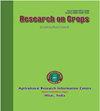Broussonetia × hanjiana M. Kim 的体外抗菌和抗氧化活性评估
Q3 Agricultural and Biological Sciences
引用次数: 0
摘要
在韩国,Broussonetia × hanjiana M. Kim(Kkujidaknamu,韩国纸桑)的果实和树皮一直被用作药物和纸张资源,用 B. × hanjiana 树皮提取物制成的韩国传统纸张(Hanji)一直被用来包装干燥食品。本研究旨在评估 B.× hanjiana 提取物的体外抗菌和抗氧化活性。通过盘扩散和最小抑菌浓度(MIC)法,评估了七月份采集的该植物乙醇提取物的四种馏分对三种革兰氏阳性菌株、两种革兰氏阴性菌株和一种酵母菌的抗菌活性。B. × hanjiana 树皮乙醇提取物的乙醚和乙酸乙酯馏分对测试的革兰氏阳性菌具有最高的抗菌活性和最低的 MIC 值。正己烷和乙醚萃取物对革兰氏阴性菌的 MIC 值在任何样品萃取物中都未检测到,对酿酒酵母的 MIC 值在任何萃取物中都未观察到。通过 1,1-二苯基-2-苦基肼(DPPH)和 2,2′-偶氮-双(3-乙基苯并噻唑啉-6-磺酸)(ABTS)自由基清除试验评估了该植物乙醇和热水提取物的抗氧化活性。无论哪种样品,乙醇提取物的 DPPH 和 ABTS 自由基清除活性都比热水提取物高。总酚和类黄酮含量的结果与抗氧化活性的结果不一致,这表明抗氧化活性不仅受多酚含量的影响,还可能受其他植物化学物质的影响。抗菌和抗氧化活性受植物器官或提取溶剂的影响。这些发现可能证实了这种植物作为抗菌剂和抗氧化剂的潜力。本文章由计算机程序翻译,如有差异,请以英文原文为准。
Assessment of in vitro antimicrobial and antioxidant activities of Broussonetia × hanjiana M. Kim
The fruit and bark of Broussonetia × hanjiana M. Kim (Kkujidaknamu, Korean paper mulberry) have been used as a resource for medicine and paper in Korea and Korean traditional paper (Hanji), made from extract of the B. × hanjiana bark, has been used to package dry foods. The present study was carried out to evaluate the in vitro antimicrobial and antioxidant activities of B.× hanjiana extract. The antimicrobial activity of four fractions of ethanol extract of the plant collected in July was evaluated through disc diffusion and minimal inhibition concentration (MIC) method against three Gram-positive strains, two Gram-negative strains, and one yeast. The ether and ethyl acetate fraction of ethanol extract from B. × hanjiana bark exhibited the highest antimicrobial activity with the lowest MIC value against the tested Gram-positive bacteria. The MIC of the hexane and ether fraction against Gram-negative bacteria was not detected in any sample extracts and the MIC was not observed against Saccharomyces cerevisiae in any fractions. The antioxidant activity of ethanol and hot water extract of the plant was evaluated by 1,1-diphenyl-2-picrylhydrazyl (DPPH) and 2,2′-azino-bis (3-ethylbenzothiazoline-6-sulfonic acid) (ABTS) radical scavenging assay. The ethanol extract showed relatively higher DPPH and ABTS radical scavenging activity than the hot water extract, regardless of the samples. The results of total phenolic and flavonoid contents were not consistent with the results of antioxidant activity and it shows antioxidant activity is not only affected by the polyphenol content but also can occur by some other phytochemicals. The antimicrobial and antioxidant activity was influenced by plant organ or extract solvent. These findings may confirm the potential of this plant as an antimicrobial and antioxidant agent.
求助全文
通过发布文献求助,成功后即可免费获取论文全文。
去求助
来源期刊

Research on Crops
Agricultural and Biological Sciences-Soil Science
CiteScore
1.50
自引率
0.00%
发文量
93
审稿时长
1 months
期刊介绍:
The Research on Crops is a peer-reviewed journal publishing original research papers, review articles and short communications in English on all basic and applied aspects of crop sciences, agricultural water management, agro-climatology, agroforestry, agronomy, crop production, crop protection, cropping systems, food science & technology, genetics & plant breeding, horticulture, plant & soil science, plant biotechnology, plant nutrition, post-harvest management of crops, seed science, soil management & tillage, vegetables, weed science, agricultural engineering, agri-business, agricultural economics and extension, etc. The aim of the journal is to provide a forum for the scientific community to publish their latest research findings.
The manuscripts submitted for publication should not contain data older than 4 years on the date of submission.
The articles submitted for publication in this journal should not be submitted elsewhere simultaneously for publication in another journal. These should not carry any copyright material without prior permission of copyright holder.
The articles should present a complete picture of the investigation made and should not be split into parts.
There is no prescribed limit regarding the number of pages in case of full-length articles. However, the authors are advised to keep the length of their articles from 4 to 10 full printed pages of the journal.
The articles should be divided into the sub-sections: ABSTRACT, INTRODUCTION, MATERIALS AND METHODS, RESULTS AND DISCUSSION, CONCLUSIONS, and REFERENCES. Tables and figures should be appended separately at the end.
 求助内容:
求助内容: 应助结果提醒方式:
应助结果提醒方式:


